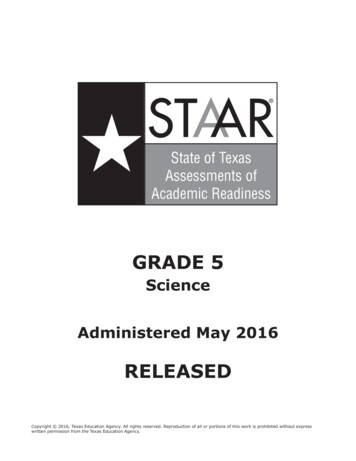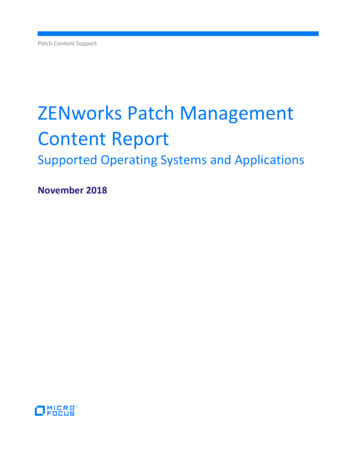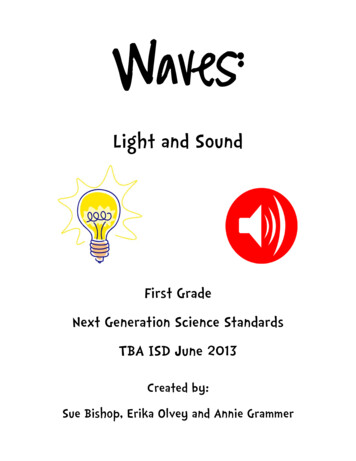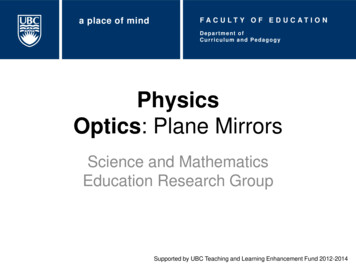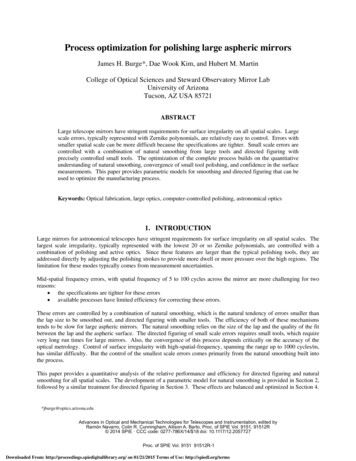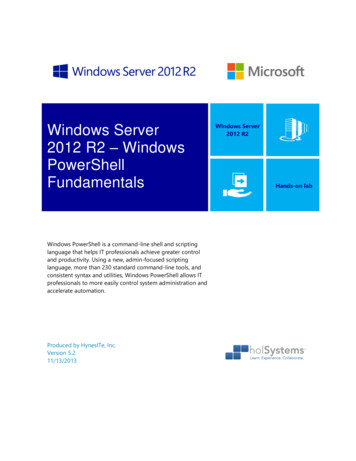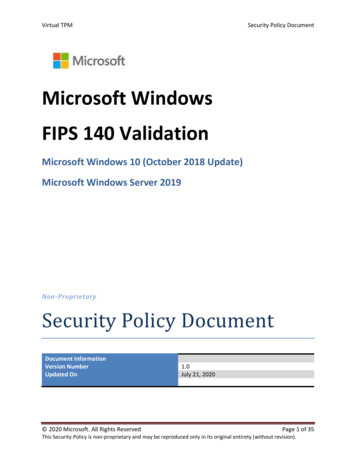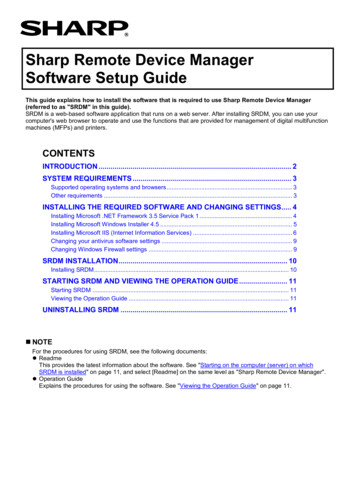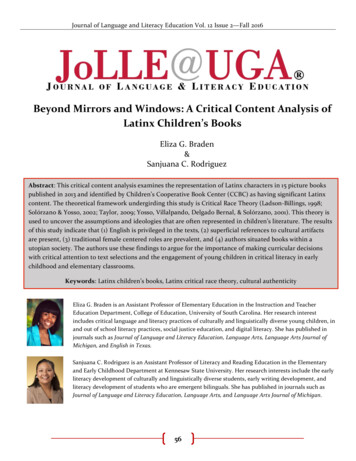
Transcription
Journal of Language and Literacy Education Vol. 12 Issue 2—Fall 2016Beyond Mirrors and Windows: A Critical Content Analysis ofLatinx Children’s BooksEliza G. Braden&Sanjuana C. RodriguezAbstract: This critical content analysis examines the representation of Latinx characters in 15 picture bookspublished in 2013 and identified by Children’s Cooperative Book Center (CCBC) as having significant Latinxcontent. The theoretical framework undergirding this study is Critical Race Theory (Ladson-Billings, 1998;Solórzano & Yosso, 2002; Taylor, 2009; Yosso, Villalpando, Delgado Bernal, & Solórzano, 2001). This theory isused to uncover the assumptions and ideologies that are often represented in children’s literature. The resultsof this study indicate that (1) English is privileged in the texts, (2) superficial references to cultural artifactsare present, (3) traditional female centered roles are prevalent, and (4) authors situated books within autopian society. The authors use these findings to argue for the importance of making curricular decisionswith critical attention to text selections and the engagement of young children in critical literacy in earlychildhood and elementary classrooms.Keywords: Latinx children’s books, Latinx critical race theory, cultural authenticityEliza G. Braden is an Assistant Professor of Elementary Education in the Instruction and TeacherEducation Department, College of Education, University of South Carolina. Her research interestincludes critical language and literacy practices of culturally and linguistically diverse young children, inand out of school literacy practices, social justice education, and digital literacy. She has published injournals such as Journal of Language and Literacy Education, Language Arts, Language Arts Journal ofMichigan, and English in Texas.Sanjuana C. Rodriguez is an Assistant Professor of Literacy and Reading Education in the Elementaryand Early Childhood Department at Kennesaw State University. Her research interests include the earlyliteracy development of culturally and linguistically diverse students, early writing development, andliteracy development of students who are emergent bilinguals. She has published in journals such asJournal of Language and Literacy Education, Language Arts, and Language Arts Journal of Michigan.56
Journal of Language and Literacy Education Vol. 12 Issue 2—Fall 2016“. And that will always be that way unlesswe kids choose to learn from city trees Someof whom are crushed by the pavement. But Iknow others who fight back and BREAKOPEN the sidewalks and grow despite ofeverything. And it is they who help us all tobreathe” (I Dreamt A Book About Hope byGabriela Olmos)In this study, we seek to examine text withsignificant Latinx content published in 2013 andsubmitted to the CCBC. The literature review thatfollows outlines the growing demographics of peoplethat identify as Latinx and the research that hasfocused on authentic representations ofunderrepresented groups in children's books.Following the literature review, we discuss how weselected the books that were used in the study andhow we gathered the data. We then move to discussthe findings and share the insights that we gained.Finally, we end with a discussion of what this studymeans for teachers and provide resources that willhelp teachers to implement a critical literacyframework.Our interest in studying books began whenwe started to have conversations aboutthe paucity of children’s literature in ourclassrooms that included Latinx characters andthemes.1 Therefore, we tried to purposefully selectliterature grounded in students’ lives. For example,Eliza selected book titles related to topics aroundimmigration when she discovered some studentswere silently dealing with the issue. As she read anumber of texts with implicit and explicit themesrelated to immigration and engaged in discussions,she wondered if the books fully encapsulated theexperiences of the Latinx immigrant children in herclass. What was troubling was that as a child,Sanjuana had a similar experience in looking forbooks that reflected her own experiences.Additionally, as we conducted an informal inventoryof our own classroom libraries, we concluded thatonly a handful of books reflected the culture of ourLatinx students. What we began to realize was that25 years after Sanjuana sought out characters thatlooked like her and reflected her family experiences;the need for books that provide those windows,mirrors, and possibilities for connections is stillthere.Literature ReviewThe number of Latinx students in U.S. schoolscontinues to grow (National Center for EducationalStatistics, 2014). Therefore, a modification to thecurriculum should be the books that are available inclassrooms. Despite the shifting demographics,Latinx students continue to be grosslyunderrepresented in children’s books (Naidoo,2008). There is also a growing need to identify howthis group of students can and should berepresented in the literature (Fox & Short, 2003;Naidoo, 2008). According to Boyd, Causey, andGalda (2015), books rarely reflect the census figuresfor the United States. The 2010 census data confirmthe diversity among the population, with 17% ofrespondents identifying themselves as Hispanic orLatinx. This study focuses on Latinx students andthe representation of Latinx students in picturebooks published in 2013 and 2014. Each year, the1We acknowledge that there is a gender spectrum andthat myriad pronouns exist that we can use whenreferring to individuals in our writing. Throughout thisarticle we will use “he” to refer to individuals who identifyas male, “she” to refer to individuals who identify asfemale, and “ze” for individuals who identify as gender-neutral. We have selected these pronouns because webelieve they are more familiar for a diverse audience ofreaders. Likewise, we have also chosen to use the term“Latinx” as a gender neutral alternative to Latino/a.57
Journal of Language and Literacy Education Vol. 12 Issue 2—Fall 2016Cooperative Children’s Book Center (CCBC)compiles a list of the children’s books that arepublished in the United States. CCBC is a source formulticultural statistics about children’s books. Ofthe 3,200 books received by the CooperativeChildren’s Book Center in 2013, only 57 books hadsignificant Latinx critical content and only 48 bookswere authored by Latinx authors or/and illustrators(Horning, Lindgren, & Schliesman, 2014).literature is the mirror in which young children seethemselves and the window to see others, thedepictions of children from diverse backgroundsshould be accurate.Reading multicultural literature becomes a windowto understanding the cultural heritage of others foryoung children and has the potential to reflectpositive images of one’s culture by acting as amirror. It also has the potential to reflect thecultural heritage of other groups. This perspectiveThe present research indicates that Latinx childrentaking approach to reading is defined by Galdafrom diverse cultural locations need the opportunity(1998) as a window. When young children areto challenge and change existing discourses (Janks,presented with literature that only reflects their2003). The inclusion of literature related to students’background, cultural heritage, and experiences, theycultural lives allows students to engage in amay believe that their experience dominates allreflection of the multiplicity ofothers. For this reason, theexperiences represented withinliterature presented in“When young children aretext; however, students come toschools—the site wherepresented with literaturethink critically when theychildren come to read, andthatonlyreflectstheirengage in discussions aroundknow themselves and others—topics which accurately portrayshould be inclusive. Children’sbackground, culturalissues related to their lives. Theliterature must give childrenheritage, and experiences,present study asks researcherspathways to interrogate andtheymaybelievethattheirand practitioners to considercontest the ways in whichexperiencedominatesallhow texts portray thecultural groups are presentedexperiences of Latinx studentswithin stories. According toothers.”and what is implicitly andBishop (1997), children fromexplicitly suggested by the text.dominant groups have found their mirrors in booksbut they too suffer from the exclusion of otherA number of researchers have demonstrated thegroups in libraries. 26 years later, we agree withcomplexity of an authentic representation inRudine Sims Bishop’s statement as she propagatedmulticultural texts (Fox & Short, 2003; Henderson,in her 1990’s column “Mirrors, Windows, and Sliding2005; McNair, 2008; Naidoo, 2008; Tolson, 2005;Glass Doors” that as xenophobic and racist beliefsYokota & Bates, 2005). However, a limited numbercontinue to plague U.S. schools and society, childrenof scholars have focused on books with Latinxneed the opportunity to discuss the social problemsthemes. The use of Latinx literature in classrooms,that ill their communities. Children’s literaturecoupled with dialogic instruction within thebecomes the place where they can offer insight,classroom context has the potential to providediscuss, interrogate, and “talk back” to the socialchildren with both a window to other cultures and aproblems they often live and struggle to make sensemirror reflecting their own culture (Galda, 1998).of in and outside of classrooms. For this reason, theBooks also provide a potential for students to makeauthors of this study believe that children’spersonal connections to texts. Since children’sliterature needs to be constantly interrogated,58
Journal of Language and Literacy Education Vol. 12 Issue 2—Fall 2016considering social problems such as racism andpoverty are constant battles for children. Therefore,as we look at the demographics of our schools withlarger numbers of Latinx students of whom andabout literature is written as identified by theChildren’s Cooperative Book Center (CCBC), westrive to examine the nature of books withsignificant Latinx content.identities, language use, and involve themselves intransnational experiences. Chappel and Faltis (2006)examined the portrayal of bilingualism and identifyaffiliations in seven picture books that dealt withbilingual and cultural themes. The titles wereselected from two notable children’s literaturescholars whose work deals with Latinx children’sliterature: Dr. Carmen Martinez-Roldán and Dr.Sarah Hudelson. The portrayal that Latinximmigrant families make a break from their culturalheritage to assimilate to mainstream Americanculture is often presented within children’sliterature but does not accurately portray the crossnational identities that many children of immigrantshold. Therefore, the studies call for an increase inthe number of bilingual materials that pay attentionto accurate portrayals of the culture depicted in thereading material for young children. This study aimsto understand nuances within children’s booksabout a specific cultural group that can add tocriteria already assessed by scholars evaluatingcultural authenticity and looking to identify furthercriteria for evaluating books. The followingquestions guided this study:Others have already examined the role of culturalauthenticity in Latinx children’s literature usingcritical content analysis. A study conducted by YooLee, Fowler, Adkins, Kim, and Davis (2014)examined the authenticity of forty-five multiculturalpicture books across three ethnic groups (AfricanAmerican, Asian Americans, and HispanicAmericans) using two selection tools: Novelist, anelectronic reader’s advisory resource and CCBC,2000-2008. First and second round analysis by twocoders from each ethnic group examined whetherstereotypical and culturally authentic features weredepicted in selected titles. The analysis revealed thatalthough the books were overall culturallyauthentic, stereotypical elements existed. Thesestereotypical elements included social dynamics likepoverty, traditional foods, and clichéd gender roles.Although the authors of this study defined thenuances they evaluated as culturally authentic,research is still needed on what criteria culturalinsiders use to evaluate the authenticity ofliterature. Concurrent with Yoo-Lee et al.’s (2014)findings that negative stereotypical features existwithin children’s literature, Martinez-Roldán (2013)found that parodies of Mexican cultural heritageexisted in the commonly known children’s bookSkippyjon Jones, which potentially created negativeimages of Mexicans, places they live, and theirlanguage.1.What experiences do the picture books withLatinx content portray?2. What cultural narratives are implicitly andexplicitly suggested by Latinx story picturebooks?Guiding FrameworkThe following section describes the framework thatguided our analysis of the Latinx picture books.Critical multicultural perspectives (Botelho &Rudman, 2009) deal with the representation ofpeople of color in children’s literature. Thisperspective deconstructs the problematicrepresentations of Latinx in literature. It challengestaken for granted assumptions about characteristicsattributed to members of a particular group. Thisstudy also seeks to deconstruct the representation ofThe extent to which culturally authenticrepresentations are presented in literature can beexamined in the ways characters construct their59
Journal of Language and Literacy Education Vol. 12 Issue 2—Fall 2016Latinxs in books that have Latinx content.According to Gutierrez and Rogoff (2003), culture isnot static and all members of a group are nothomogeneous nor do they share the sameexperiences.issues related to the lives of Latinxs. According toBeach et al.,Critical theories are put into dialogue withchildren’s literature so that we can moredeeply understand the cultural, social,political, and economic contexts of children’stexts and the ways in which these texts shapehow children view and interact with thesocial world.” (2009, p. 166)Therefore, our framework relies on Critical RaceTheory (Ladson-Billings, 1998; Solórzano & Yosso,2002; Taylor, 2009; Yosso, Villalpando, DelgadoBernal, & Solórzano, 2001) to uncover theassumptions and ideologies that are oftenrepresented in children’s literature. Critical raceAs researchers, we acknowledge that the contexttheory largely grew out of legal studies in the 1990smatters and that books have the power to shape andthat challenged the system's structure which largelyshift how children view the world. By using LatCrit,privileged white people. A goal of CRT is to ridwe aim to make the voices of Latinx children andstructures of racial oppression. In the field offamilies central to our research. This study aims toeducation, the perspective has critiqued curriculum,legitimize the intricate communities that exist forinstruction, and funding (Ladson-Billings, 1999).Latinxs. We believe that children’s books are notThis study uses CRT to examineneutral, but they provide“By using LatCrit, we aim toLatinx children’s literature. Weinsights into the intricate naturechoose to draw on theof different communities. Asmake the voices of Latinxdefinition that views CRT inchildren and families central scholars of color, we understandeducation as “a framework orthat there is hegemony oftoourresearch.”set of basic insights,whiteness (Winograd, 2011) thatperspectives, methods, andexists in education practice andpedagogy that seeks to identify, analyze, andresearch. Although well intentioned, authors may intransform those structural and cultural aspects offact continue to perpetuate the majority way ineducation that maintain subordinate and dominantdesign of children’s books for Latinx childrenracial positions in and out of the classroom”because of the Eurocentric normative practices.(Solorzano & Yosso, 2002, p. 25). As a theoreticalThus, leaving young children to feel “left out” andframework, CRT allows us to critically examinenot reflected in educational practices and children’sissues related to race and to challenge dominant andliterature which stands is at the heart of earlyaccepted ways in which groups are positioned.childhood and elementary classrooms. The nextDrawing on Critical Race Theory will allow us tosection will provide a description of how the booksidentify those explicit and implicit assumptions andfor this study were selected.ideologies in the picture books. An extension ofCRT, Latino Critical Race Theory (LatCrit), pushesOur Criteria for Selecting Booksthe envelope further by examining how Latinxsexperience race, class, gender, and sexuality. InThe books that were selected for this study wereparticular, LatCrit (Delgado Bernal 2002; Espinoza &books published in 2013 and received by CooperativeHarris, 1997; Yosso, 2006) allows us to focus on theChildren's Book Center (CCBC) at the University ofWisconsin-Madison. The CCBC is a unique research60
Journal of Language and Literacy Education Vol. 12 Issue 2—Fall 2016library for children and young adult literature. Thesebooks were listed as books received with Latinxcontent. The 2013 list contained 57 book titles with avariety of genres and formats. These includedchapter books, informational text, poetry, andpicture books. For the purpose of our study, wedecided to study only story picture books. Wenarrowed our selection to story picture books due tothe cultural and heritage related themes that may betranslated through illustrations, characters, andlanguage use in books. The books were also chosenbecause story picture books are read more often inearly childhood and elementary settings. Therefore,we are primarily concerned in this study with howfictional narratives and cultural messages related toLatinxs are authentically transmitted to children inearly childhood and elementary settings. We alsochose to exclude informational texts since they donot inform our research questions for this study.After establishing criteria for the books that wewould use, we included 15 books that met ourestablished criteria. The book titles and descriptionsare included in Table 1.Chihuahua dogs has been seen as a racial stereotypeof Mexicans by other researchers. The criticalcontent analysis reveals what text is about (Galda,Ash, & Cullinan, 2000). Therefore, the text is notlimited to words but can also include any object,such as pictures and other images, that holdmeaning for someone or is produced to havemeaning (Krippendorff, 2004, p. 19). Thus, thecritical content analysis is an appropriate method toutilize while investigating cultural artifacts such asbooks and pictures as it allows the researcher tolook at both text and pictures. Understanding thehistorical and political contexts of Latinxs in theUnited States and the present trends in children’sliterature, this study will focus on therepresentational issues (i.e., language, culturalconstructions, race, class, gender) and powerrelationships within books. Our study of these bookswas guided by the following research questions:What experiences do the picture books with Latinxcontent portray? And what cultural narratives areimplicitly and explicitly suggested by Latinx storypicture books?Gathering DataThe texts identified by the Cooperative Children’sBook Center were ordered and gathered from anonline bookseller. We used an inductive procedurein addition to the guiding questions constructed byMendoza and Reese (2001). In addition to our ownresearch questions, we chose to use Mendoza andReese’s (2001) guiding questions for our analysis ofpicture books:For this study, we infused methods from Bradford’s(2007) critical content analysis with Botehlo andRudman’s (2009) critical multicultural analysis toinvestigate the themes and contents of Latinxchildren’s literature compiled by the CooperativeChildren’s Book Center in 2013. Martinez-Roldán(2013) conducted a critical investigation usingBradford’s (2007) and Botehlo and Rudman’s (2009)methods for the widely popular children’s literatureSkippyjon Jones. Martinez-Roldan (2013) uncoveredthat the author’s representation of language use andparodies of Mexican culture may affect children’sself-image and degrade the Mexican culture. Forexample, Martinez-Roldán (2013) describes howMexicans are represented by Chihuahua dogs in theSkippyjon Jones books and how the use of 61Are characters outside the mainstreamculture depicted as individuals or ascaricatures?Does their representation include significantspecific cultural information? Or does itfollow stereotypes?Who has the wisdom?
Journal of Language and Literacy Education Vol. 12 Issue 2—Fall 2016 For the purpose of this article, we have chosen tohighlight four insights found in the books in ourstudy. We are choosing to highlight these insightsbecause they were the most prevalent insights thatwere related to our research questions. The firstinsight that will be discussed is the way in whichEnglish is privileged in the text. The second insightillustrates how the books fail to include significantcultural context and instead provide superficialreferences to cultural artifacts. The third insightidentified from the data shows how the books relyon traditional gender roles. Our last insight dealswith the backdrop and setting being framed as autopian society. Each of the findings is discussed indepth in the following sections.How is the language used to create images ofpeople of a particular group? How are artisticelements used to create those images?This framework gave us a starting point to begin toexamine the text and to help us to think aboutcultural authenticity in the books. Similar to YooLee et al. (2014), we recognize that our study doesnot fully capture the criteria to evaluate culturalauthenticity of texts. However, the guidingframework allowed us to have a starting point andhelped us to get a clear sense of the unspokenquestions that we were encountering as we read thebooks. We began our analysis of the picture booksby reading several of the texts together andestablishing a framework for reading and analyzing.We established a common understanding of howthey would be analyzed in order to complete theremaining analysis independently. We analyzed datacontinuously during the data collection phase of thisstudy. We first read the texts to get a holistic idea ofthe storyline. We then reread the texts page by page,considering the representations, ideologies, andassumptions demonstrated within the text. Initialcoding involved reading each sentence and page toexamine how Latinx characters were described andwhat was being described about them. We created aspreadsheet that included titles and summaries of allof the texts. While we conducted the initial coding,we continually went back to our research questionas well as Mendoza and Reese’s (2001) guidingquestions. After our initial coding, we constructed anumber of categories that served to explicate theimplicit and explicit ways children’s literatureappears to foster representational issues of Latinxs.The coding of the text revealed several insightsabout the books. Table 3 displays these book titlesand the insights that were identified in each of thebooks.English is PrivilegedThrough our analysis of the Latinx children’s books,we found several manifestations of English’sprivileged status. We use the term privilege todenote more significance being given to onelanguage over the other. Language is an importantmarker of culture and therefore we wondered if onelanguage was portrayed as more or less significantthan the other. One of the themes that emergedfrom the analysis is that English is privileged in mostof the books through the way that it is presented inthe layout of the text and also through the way thatthe texts were limited in the use of Spanish or otherlanguages. Most of the texts that were analyzed werewritten solely in English, but also included somewords in Spanish. This was to be expected since thebooks that were studied were published in theUnited States, but we did not expect it to be soprevalent since the books contained Latinx content.Eight of the books were bilingual books and theothers were written solely in English. We believethat it is important to consider how language isprivileged in the books and how it advantages someand disadvantages others.Insights62
Journal of Language and Literacy Education Vol. 12 Issue 2—Fall 2016mami, and papi in Spanish. An example of kinshipterms being used and introduced without atranslation is the book Pancho Rabbit and the Coyote(Tonatiuh, 2013). This book included the terms, Papaand Mama. These terms and salutations such asSeñor were included within the English text withoutthe translation. These kinship terms did not includetranslations and were not introduced in the text;therefore, readers were expected to translate theterms or understand their Spanish translation. Table2 represents the use of Spanish words in either theEnglish translation of the text for bilingual books orthe use of Spanish words in the books written solelyin English.Walker, Edwards, and Blackswell (1996) determinedthree categories in which bilingual books could becritiqued. Those three categories includetypography, production, and language. The keyquestion in regards to typography asked by theresearchers is, “are typographic features such as size,space, weight, and color applied consistently acrossboth languages?” (Walker, Edwards, & Blackswell,1996, p. 275) Across all of the bilingual books, theEnglish and Spanish texts were the same size, space,and weight. The production of the text deals withthe way that the pictures and text were published. Inmost of these books, with the exception of one book,English was featured moreprominently. The layout andOur findings of the use of“Our findings of the use ofposition of the text falls underSpanish words embeddedSpanishwordsembeddedthe category of production. Thewithin English text arelayout of the text is importantcongruent with the Barrera andwithin English text areas it cues the reader to whatQuiroa (2003) findings thatcongruent with the Barreralanguage should be read first.suggest that Spanish words orandQuiroa(2003)findingsIn bilingual books, the Englishphrases are added simply tothatsuggestthatSpanishtranslation of the text wasadd cultural flavor to the text.always presented at the top ofBarrera and Quiroa (2003) statewords or phrases are addedthe page. This can send thethat “Spanish words andsimply to add cultural flavormessage that the Englishphrases hold considerabletothetext.”language is more significant.potential for enhancing theAdditionally, the Englishrealism and culturaltranslation was always written on the left page,authenticity of English-based texts, specifically bywhich is typically read first. Many of the books thatcreating powerful bilingual images of characters,were written in English did include some words insettings, and themes” (p. 247). Considering the lowSpanish. The use of Spanish in these books wasfrequency of Spanish terms used in the Englishmostly superficial and included words that werebased texts and the English translations in the booksoften translated. For example, the book Whenthat we studied prompts us to question theChristmas Feels Like Home (Griffith, 2013), a bookaudiences for whom these books were written.that details the story of a little boy that moves to aJudging on the basis of the use of Spanish, we cannew town, included words such as vamos, and thedetermine that these books were written forphrase no se puede. These more complex wordsmonolingual (English) readers and that there isalmost always included the direct translation for theprivileging of the English language in the text. It iswords before or after the word(s) were introduced inalso important to consider the power associatedthe text. The book also included kinship termswith this privilege. In her account of historical(terms related to family) such as abuelo, tio, tia,privilege that the English language has had in63
Journal of Language and Literacy Education Vol. 12 Issue 2—Fall 2016schools, García (2014) notes that the concept ofpower “determines whose language is taught andwhich language practices are taught and which areminoritized” (p. 89). In U.S. schools, the Englishlanguage continues to be privileged and thusstudents who are fluent in English are afforded morepower in the classroom (Cummins, 2000). This issignificant because literature helps children makesense of their world, including the ways in whichthey view language.instances where children are allowed to use their fulllinguistic repertories (García & Yip, 2015).Cultural AuthenticityAnother insight that emerged from the study of theLatinx picture books is related to culturalauthenticity. The idea of cultural authenticity iscomplex and has generated debates due to varyingperspectives from those who study and teachmulticultural literature (Bishop, 2003). In theiredited work about cultural authenticity in children’sbooks, Fox and Short (2003) discuss the issue ofcultural authenticity and describe it this way:“cultural authenticity cannot be defined, although‘you know it when you see it’ as an insider reading abook about your own culture” (p. 4). As for thisstudy, we adopt Yokota’s (1993) characteristics forcultural authenticity as being “richness of culturaldetails, authentic dialogue and relationships, indepth treatment of cultural issues, and the inclusionof minority groups for a purpose” (p. 160). In ourstudy of the picture books, it was helpful to have oneof us who is an insider to the Latinx culture.Sanjuana found that many cultural nuances placedin the text were superficial. This is not to say that wewant to generalize characteristics of the Latinxculture, but the degree in which authors regardedLatinx culture lacked depth and breadth. In ouranalysis, only a few books included authentic Latinxcultural details. Most other texts make superficialmentions of cultural artifacts. Many of the symbolsthat were included in the text were superficia
Latinx Children's Books Abstract: This critical content analysis examines the representation of Latinx characters in 15 picture books published in 2013 and identified by Children's Cooperative Book Center (CCBC) as having significant Latinx content. The theoretical framework undergirding this study is Critical Race Theory (Ladson-Billings .
